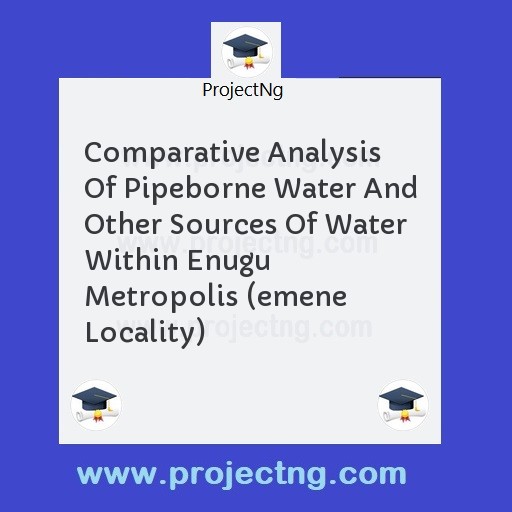Comparative Analysis Of Pipeborne Water And Other Sources Of Water Within Enugu Metropolis (emene Locality)
Science Lab Technology Project Topics
Get the Complete Project Materials Now! »
COMPARATIVE ANALYSIS OF PIPEBORNE WATER AND OTHER SOURCES OF WATER WITHIN ENUGU METROPOLIS (EMENE LOCALITY)
ABSTRACT
Comparative analysis of water was carried out on well water, stream and pipe born water obviated within Emene locality of Enugu state the sample were subjected to some analytical tests final like presumptive tests, comfirmative test final like presumptive tests, comfirmative test, completed test, indole test and plate count for the organism that develop on the culture, the result show that well water and stream were found to contain pathogenic organism like salmonella, Shigella and staphylococcus aureus as well as numerous viable counts, the cloform or the indicator organisms Escherichia coli the family of enterbactercteriaceae were isolated too form well water the pipe borne water a sample contained staphylococcus aureus and have lowtotal viable counts.
TABLE OF CONTENTS
Title page
Project topic
Certification
Dedication
Acknowledgement
Abstract
Table of contacts
List of table
List of figures
CHAPTER ONE: INTRODUCTION
1.1 Aims and objective
1.2 Statement of problem
1.3 Hypothesis
1.4 Significance of study
1.5 Limitations
2.0 CHAPTER TWO LITERATURE REVIEW
2.1 water analysis
3.0 CHAPTER THREE: MATERIALS AND METHOD
3.1 Sample collection
3.2 Preparation of media
3.3 Sterilization of materials
3.4 Multiple tubes technique
3.5 Presumptive test
3.6 Confirmed test
3.7 Completed test
3.8 Test for indole
3.9 Methyl red test
3.10 Oxidase test
3.1.1 catalse test
3.12 plate counts techniques
3.13 preparation of single and double strength media
3.14 dilution technique in most problem number `
3.15 Inoculation of media with water samoltes
GRAM STAIN TECHNIQUE
4.0 CHAPTER FOUR: RESULTS
4.1 Colony counts
4.2 Most problem number (mpn) and pH result.
5.0 Chapter five. Discussion an
5.1 Discussion
5.2 Recommendation
5.3 Conclusion
6.0 references
Appendix
LIST OF TABLE S
Table I comparative guality of ground water and surface water
12
Table II colony count result 25
Table III MPN and PH result 25
Table IV the MPN of cliform in the dilution 27
Table V the physiological biochemical of the isolated organisms 28
List of figures
Fig I culture plate picture 23
Fig II isolated micro organisms and shape 24
CHAPTER ONE
INTRODUCTION
Following the theory of creation, it is clear that water is as old as man. From time immemorial, man has restorted to the use of this unique commodity for domestic and other purposes.
Most of our water supplies are from surface water which include: rivers, streams, lakes, oceans and seas and there water bodies are likely to be polluted with domestic and Industrial as well as agriculture waste, As populations increase, the problem become more serious and as such, water can endanger the health and life of human beings because when polluted by fecal materials it becomes potential carrier of pathogenic organism (Carpenter 1977).
Water, is of course, absolutely essential to life, not only human life but all life, animal and vegetable. Most of the biochemical reaction that occur in metabolism and growth of living cells involved water, and all take places in water. (Camp etal,1974).
Man uses water not only for drinking purposes but also for bathing, washing, laundering, heating, air conditioning, agriculture, stock raising and gardens, Industrial processes and cooling water power and steam power, fire protection, fishing, swimming and wild life propagation and navigation.
Natural water contain not only then natural flora but also micro – organisms from soil and possible from animals or sewage. Surface waters in streams or pools and stored waters in lakes and large ponds vary considerably in microbial content. (frazier 1978) water is broadly divided into three types viz., surface water which include: streams, rivers, lakes sear, and oceans Kelman et al (1957)
The ground water, well borehle, many people have defined the ground water in different ways: ground water is subter water that occurs where all pores in the soil or rock counting materials are saturated (pelezer et al 1992).
Be the First to Share On Social















